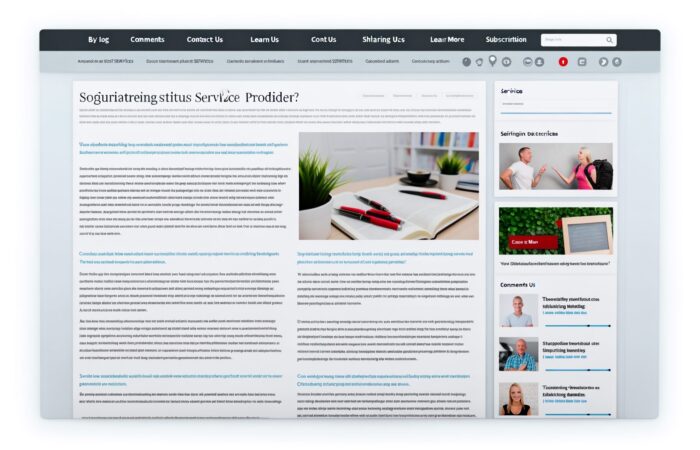Getting to Grips with SEO Basics
Hey there! If you’re looking to understand the foundational blocks of Search Engine Optimization (SEO), you’ve come to the right place. Think of SEO as the art and science of making your web content attractive to search engines like Google and Bing. It’s a bit like setting the stage for your website to perform in front of an audience that’s always changing preferences!
First off, what exactly is SEO? Well, it’s the process employed to increase the quality and quantity of traffic to your website through organic search engine results. The main aim? To make your site more visible to people who are using search engines to find solutions. SEO isn’t just about building search engine-friendly websites. It’s about making your site better for people too.
So, how does a search engine like Google work?
Imagine Google as a librarian for the world’s largest library. But instead of books, this library stores copies of all the web pages out there. When you ask Google a question, it scours its colossal index of pages and pulls out the ones it thinks are the most relevant to your query, delivering them as a neatly organized search results page.
Two Main Aspects of SEO: On-Page and Off-Page
- On-Page SEO: This involves making sure your site’s pages are well-structured, both in terms of actual content (like text, images, and videos) and HTML (the code that runs behind the scenes). From using the right keywords to making your site easily navigable, on-page factors are within your control.
- Off-Page SEO: This relates to external factors that don’t involve changes to your website itself. Off-page SEO is mostly tied to the quality of links from other sites pointing to your site, often referred to as backlinks. This part can be trickier since it involves earning credibility and authority from other online sources.
Why is SEO Important?
In today’s digital-first world, having a strong online presence is crucial. Search engines serve millions of users per day looking for answers to their questions or solutions to their problems. If you have a website, blog, or online store, SEO can help your business grow and meet the business objectives. Good SEO practices improve the user experience and usability of a website, which leads to better conversion rates.
SEO is a Marathon, Not a Sprint
It’s important to remember that SEO takes time. Consider it a long-term investment. Rankings improve over time, and maintaining those rankings requires constant effort and updating. Once your website starts to climb up in search results, you’ll likely see a significant impact on your business’s success.
In our journey ahead, we’ll dive deeper into optimizing your content, harnessing keywords’ power, and enhancing user engagement through tailored strategies. But understanding these SEO basics first sets you up on the right path to becoming an SEO wizard!
Ready to boost your site’s visibility?
Stick with me! It’s an adventurous path, but oh, it’s worth it—helping people find exactly what they’re looking for while navigating the vast ocean of the internet.
Key Metrics for Analyzing Content Performance
So, you’ve got your content up and running, and now it’s time to dive into the nitty-gritty: how is your content actually performing? It’s like being a coach on the sidelines, watching how the game plays out, ready to make the necessary tweaks to your strategy. Here are some essential metrics that help you do just that!
1. Traffic Sources
Understanding where your visitors come from is crucial. Are they typing your URL directly into their browsers, finding you through Google, or clicking on a link from social media? This info helps you pinpoint which channels are working best and where you might need to beef up your efforts.
- Direct traffic: These visitors know who you are; they’re typing your website directly into their browser.
- Organic search: These folks found you through a search engine — thanks to your stellar SEO skills!
- Referral traffic: These users clicked on a link from another site that led them to you.
- Social traffic: These are the visitors coming from social media platforms. It’s a good measure of how effective your social media strategies are.
2. Bounce Rate
Ever thrown a party and had someone pop in only to leave immediately? That’s your bounce rate. It tells you the percentage of visitors who left your site after viewing just one page. A high bounce rate might suggest that your landing pages are not engaging or relevant enough.
3. Conversion Rate
It’s not just about getting visitors to your site; it’s about getting them to act. Whether it’s signing up for a newsletter, downloading a guide, or making a purchase, your conversion rate tracks how well your site turns visitors into customers or subscribers.
4. Average Time on Page
Time is a metric of interest and engagement. The average time on page gives you an idea of how long people are sticking around. More time spent can be a good indicator of content quality — unless they’re just lost on your site, which you don’t want!
5. Page Views
Track the number of page views to see which pieces of content are most popular. This metric is super useful for understanding what topics your audience is really interested in.
6. Click-Through Rate (CTR)
When you send out an email or post a link, the click-through rate tells you what percentage of people are compelled to click. High CTR? You’re on the right track. Low CTR? Time to revisit your call-to-action.
Armed with these metrics, you can play detective, uncover the stories behind the numbers, and make informed decisions that boost your content’s performance. Remember, the goal is to learn and adapt. By understanding the highs and lows of your content’s journey, you’re better equipped to tweak, refine, and ultimately succeed in the digital landscape. So, keep an eye on these metrics, listen to what they tell you, and don’t be afraid to change the game plan if necessary. Your audience will thank you for it!
Tools and Techniques for SEO Analysis
So, you’ve got a grip on SEO basics, right? Great! Now let’s dive into the exciting world of SEO analysis tools and techniques. These are the magnifying glasses through which we can zoom in on what’s working and tweak what isn’t. Ready to play detective with your website’s data? Let’s go!
Start with the Right Tools
Imagine trying to fix a car with just a hammer. Pretty ineffective, right? The same goes for SEO. You need the right tools for different tasks. Here are a few fan-favorites:
- Google Analytics: The Swiss Army knife of SEO tools. It helps you understand who visits your site, how they got there, and what they did during their visit.
- Google Search Console: This tool shows you how Google views your site. It’s fantastic for spotting issues and seeing what queries bring people to your site.
- Ahrefs: It’s a bit like having a drone that scouts the landscape of your website and your competitors. Ahrefs helps with checking backlinks, keywords, and ranking profiles.
- SEMrush: Another powerhouse, especially useful for keyword research and competitive analysis. It’s like having a spyglass to see what your competitors are up to.
- Moz: Great for page optimization insights and when you’re getting serious about enhancing your SEO game across the board.
Techniques That Make a Difference
Having snazzy tools is one thing, but knowing how to use them effectively is what really separates the pros from the amateurs. Here’s how you can leverage these tools:
- Regular Audits: Schedule weekly or monthly SEO audits to check for common issues like broken links, over-optimized content, or speed optimizations. Think of it as routine maintenance for your site.
- Monitor Your Competitors: Keep an eye on your top competitors with tools like SEMrush or Ahrefs. See what keywords they are climbing the ranks for and adapt your strategy accordingly.
- Keyword Tracking: Use Google Analytics and Google Search Console to track how your chosen keywords are performing. Don’t just set and forget; pivot as necessary.
- Content Gap Analysis: Use Ahrefs to identify topics your competitors cover that you don’t. It’s like finding the missing pieces of your content puzzle.
- Backlink Analysis: Regularly check your link profile with tools like Moz and Ahrefs to make sure you’re building healthy and quality backlinks.
Think of SEO tools and techniques as your digital magnifying glass and trench coat, making you the Sherlock of search engine optimization. By staying curious, observant, and a bit experimental, you’ll ensure that your website not only meets the mark but surpasses it. So grab these tools and techniques, and start optimizing with confidence!
Optimizing Your Titles and Meta Descriptions
Alright, let’s dive into something that can really spice up your SEO game – optimizing those nifty titles and meta descriptions. Think of your title and meta description as the welcome mat and front door to your website’s content. They’re your first, and sometimes only, chance to make a good impression on both search engines and users.
Why They Matter
First things first, why bother tuning up your title tags and meta descriptions? Well, they play a vital role in helping your content stand out in the crowded space of search engine results pages (SERPs). A well-crafted title can be the decisive factor in whether a user clicks on your page or scrolls past it, while an engaging meta description provides a brief preview of what your content entails, enticing readers to dive into the full story.
Creating Click-Worthy Titles
Creating titles that catch the eye involves a bit of art mingled with science. Here’s how you can master this blend:
- Be clear and concise: Ensure your title directly reflects the content. Search engines typically display the first 50–60 characters of a title, so keep it short and sweet.
- Include targeted keywords: Keywords aren’t just for content – they’re gold for titles too. Including a primary keyword can significantly improve your search ranking.
- Invoke curiosity: Ask a question or make a surprising statement. Titles that spark curiosity can drive higher click-through rates.
Mastering Meta Descriptions
While not directly influencing SEO ranking, meta descriptions are essential for providing sneak peeks at your content. Here’s how to make the most of them:
- Use active voice and compelling language: Encourage users to take action by making your descriptions irresistible.
- Include a call-to-action: Sometimes it’s beneficial to be direct. A call-to-action like “Learn more,” “Get started,” or “Discover why” can move someone from just browsing to actively engaging.
- Keep it under 160 characters: This is not a hard limit, but since Google truncates longer descriptions, staying within this range ensures your whole message gets seen.
Remember, while it’s essential to optimize for search engines, you’re ultimately crafting these pieces for humans. Your titles and descriptions should not only comply with SEO best practices but also resonate with your audience. They should convey the value of what you’re offering and reflect the tone and style of your brand. Mixing relevance with creativity here can lead to better engagement and, ultimately, superior SEO results.
Harnessing the Power of Keywords
When it comes to boosting your website’s visibility, keywords are like the secret spices in your marketing mix—they can make or break your SEO efforts. But don’t worry, getting them right isn’t as daunting as it sounds. It’s more about understanding your audience and how they search for content like yours.
Let’s break it down so you can get a handle on how to use keywords to charm the search engines and captivate your audience.
Understanding Keyword Relevance
To start with, knowing what your audience is searching for and why is crucial. This requires a bit of detective work—think about the questions they have and the problems they need solutions for. Tools like Google Keyword Planner or SEMrush can help you unearth these golden nuggets of keywords.
Types of Keywords
You might have heard marketers tossing around terms like ‘short-tail’ and ‘long-tail’ keywords. Here’s a quick rundown:
- Short-tail keywords: These are broad, often composed of one or two words. Think “pizza recipe” or “blogging tips.”
- Long-tail keywords: These are more specific and often longer queries. For instance, “easy homemade pizza recipes for beginners” or “blogging tips for absolute newbies.”
While short-tail keywords may have higher search volumes, long-tail keywords often have less competition and a higher conversion rate. That’s because they catch users later in the buying cycle who are more likely to convert.
Utilizing Keywords Effectively
Once you’ve selected the best keywords, it’s not just about stuffing them into your content. That’s a no-no. Instead, integrate them smoothly into your:
- Titles: Craft titles that are enticing and include your main keyword.
- Meta descriptions: These brief descriptions are your sales pitch in the search results. Include your keywords to show relevance.
- Headers and body text: Use keywords naturally in your headers and throughout your content to maintain readability and engagement.
- URLs: If possible, incorporate the primary keyword into your page URL.
- Alt tags: These are used within an HTML code to describe images. They help search engines understand the images and improve accessibility.
By integrating keywords thoughtfully, you help search engines understand your content better. This increases the likelihood that your content will meet the right users—those who are eager to engage with what you have to offer.
Remember, the goal is to make your content as user-friendly as possible. When you focus too heavily on keywords, you risk alienating real people. Maintain a natural flow and consider your audience’s needs above all. Let’s not just feed the search engines but serve up content that’s genuinely useful and enjoyable for your human readers!
Improving User Engagement and Experience
When it comes to boosting your website’s SEO, enhancing user engagement and experience is like adding a little extra spice to your favorite dish. It makes everything better! After all, what’s the point of driving traffic to your site if visitors aren’t sticking around or interacting with your content?
So, how can you make your site not just a one-stop visit but a regular destination for users?
1. Make Your Website Lightning Fast
No one likes to wait, especially online. If your website takes more than a few seconds to load, chances are, your visitors might not stick around. Tools like Google PageSpeed Insights can help you identify what’s slowing down your site and offer practical fixes to improve load times.
2. Ensure Mobile-Friendliness
In today’s mobile-first world, your site must perform flawlessly on smartphones and tablets. A mobile-friendly design adapts to smaller screens, making navigation a breeze. Google’s Mobile-Friendly Test can tell you if your site is up to par with mobile standards.
3. Create Engaging and Valuable Content
Content is king, but engaging content is the master of the universe! Use a mix of formats like videos, infographics, and blogs to keep your audience interested. Make sure your content solves problems, entertains, or enriches your audience’s lives in some way.
Ever been lost in a maze? That’s how users feel with poor site navigation. An intuitive, well-structured site that’s easy to explore encourages visitors to stay longer and interact more. Think of your website structure as your home’s blueprint; it should make sense at a glance!
5. Interactive Elements
Add interactive elements like polls, quizzes, or interactive infographics. These tools engage users more deeply than static content and can provide valuable insights into your audience’s preferences and behaviors.
6. Utilize Chatbots and Live Chat
Immediate responses to user queries can significantly enhance user experience. Integrating chatbots or live chat support ensures that visitors can have their questions answered any time, improving the chances they’ll stay engaged with your site.
7. Regular Updates and Fresh Content
Keep your content fresh and updated! Websites that routinely update their content not only offer more value to users but also appear more reliable and trustworthy to search engines.
Improving user engagement and experience is an ongoing journey and not just a set-and-forget part of your SEO strategy. By focusing on making your website enjoyable and easy to use, you’ll not only see better engagement metrics but also a boost in your SEO rankings. Remember, a happy visitor is a returning visitor!
Using Analytics to Continually Refine Content Strategy
Ah, analytics! While it might sound a tad daunting or dry, it’s genuinely the golden ticket to refining your content strategy. Think of analytics as your secret compass, guiding you through the vast seas of content creation, leading you to make more informed, smart decisions that can significantly uplift your website’s performance.
So, how do you use this powerful tool to spruce up your content strategy? Let’s dive in!
1. Track User Behavior
First things first, understanding how users interact with your site is crucial. Whether it’s which articles they linger on or the ones they bounce off from swiftly, these insights are invaluable. Platforms like Google Analytics offer metrics like ‘Average Session Duration’ and ‘Bounce Rate’ that help paint a clear picture of user engagement. Noticing a high bounce rate? Maybe it’s time to tweak those headlines or adjust the content to be more engaging.
2. Analyze Traffic Sources
Knowing where your audience comes from is equally important. Are your visitors flocking in through social media, organic search, or are they directed via referrals? Tools like SEMrush or Ahrefs can provide detailed reports on traffic sources. This knowledge allows you to tailor your content strategy to bolster the weaker channels or double down on the stronger ones.
3. Monitor Keywords Performance
Keywords are the backbone of SEO, and tracking their performance can give you insights on what your audience is really looking for. Sometimes, a slight pivot in keyword strategy can lead to significant gains. Use keyword analytics to identify high-performing keywords and also to spot opportunities with low-hanging fruits (terms with high search volume but low competition).
Remember, analytics is not just about numbers; it’s about stories. Stories about your content and its journey on the internet. Here’s a simple approach to begin with:
- Set Clear Goals: What’s your main aim with your content? Awareness, leads, engagement?
- Measure The Right Metrics: Align these metrics with your goals. If it’s engagement, look at time on site and pages per session.
- Review Regularly: Make analytics a routine. The more regularly you check, the quicker you can adapt and optimize.
- Test and Learn: Don’t be afraid to experiment based on data insights. The digital world is always evolving, and so should your strategies.
Incorporating these analytical practices into your everyday content strategy isn’t just beneficial; it’s essential in today’s data-driven world. Every piece of data tells a part of your content’s story, and by continually adapting based on these insights, you ensure your content remains relevant, engaging, and successful.
Remember, the key to a refined content strategy is not just creation but evolution. Let analytics lead the way to this continuous improvement and watch how your content starts hitting all the right notes with your audience!











No Comment! Be the first one.